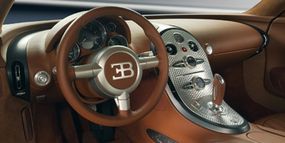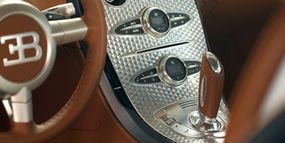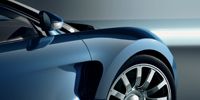The Tires and Interior
Even the tires for the Veyron are unique. They're specially designed by Michelin to handle the stress of driving at 250 mph. The tires need to be sticky like a race car's and able to handle 1.3 G's on the skidpad. However, they also need to last longer than the 70 or so miles of a typical race tire.
Michelin therefore created completely new tires to handle the Veyron's unique requirements. In the rear, the tires are 14.4 inches (36.6 cm) wide. Specifically, the tires measure 245/690 R 520 A front and 365/710 R 540 A rear, where 245 and 365 are the width in millimeters (9.5 and 14.4 inches respectively). The rims are 520 mm and 540 mm in diameter (approximately 20 inches). These tires, in other words, are massive -- the rears are the widest ever produced for a passenger car.
Advertisement
The tires use the Michelin PAX system. Their pressure is monitored automatically, and they can run flat for approximately 125 miles (201 km) at 50 mph (80 kph). According to Michelin, the run-flat detection system "plays an integral role in active safety in PAX System. Its role is to inform you of a loss of pressure, either gradual or sudden." Once warned of an air leak by the PAX system, you can reduce your speed and head toward a tire repair center.
One advantage of the PAX system and its run-flat ability is that it eliminates the need for a spare tire.


The Interior
The Veyron seats two in lavish style. The interior is swathed almost completely in leather -- the dash, seats, floor and sides are all leather. Only the instruments and a few metal trim pieces interrupt the leather experience.
The car also surrounds its occupants with every sort of electronic nicety, including a remarkable stereo system, navigation system, etc.
Is all of this worth a million bucks? Who knows. But regardless, the Veyron represents a remarkable technological achievement.
The Veyron is also likely to represent the far end of the automotive performance spectrum for some time to come. To create a car much faster will require adding even more weight, and delivering even more power to the wheels. The added weight means diminishing returns in the power-to-weight domain. Additional power means more wheelspin.
Look at a Champ car and consider how radical its appearance is compared to a passenger car. Consider also that a Champ car does not go much faster than the Veyron. The Veyron probably approaches the outer limits of the passenger car envelope, and we are unlikely to see much beyond the Veyron in terms of performance.
This is, in other words, as good as it gets.
For more information on the Bugatti Veyron and other high-performance luxury cars, check out the links below.
Related HowStuffWorks Article
- Quiz Corner: Bugatti Veyron Quiz
- How Maybachs Work
- How Car Engines Work
- How Turbochargers Work
- How Horsepower Works
- How Four-wheel Drive Works
- How Champ Cars Work
- How NASCAR Race Cars Work
- The 1969 Chevy Camaro Z28 Explained
- The 1970 Plymouth Roadrunner Hemi Explained
- The 1968 Ford Mustange 428 Cobra Jet Explained
